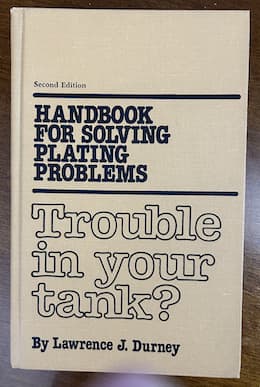
Home of the world famous 'finishing.com HOTLINE' (since 1989)
-----
Measuring the hardness of the anodized layer
Q. We would like to know how the hardness of the anodized layer can be measured and how this hardness can be increased.
Thank you in advance and we look forward to your helpful advice.
Best regards,
- Iran
2006
A. Hi Poova. There are two approaches to going for maximum hardness. First is to go strictly "by the book". If you wish to do that, you must actually go to the book -- directly to a hard copy of genuine reference material like The Surface Finishing and Treatment of Aluminum and its Alloys [adv: suggestions on AbeBooks, Amazon & eBay affil links] or Properties of Electrodeposited Metals and Alloys [affil link to Amazon or on AbeBooks affil links] , make a copy of applicable pages, highlight them, open a file documenting exactly what you are doing to follow them. Larry Durney's "Trouble in Your Tank" devotes the entire third chapter to "Follow the Letter of the Law", explaining why seeking quick tips promotes an intellectual laziness that will usually prove unproductive.
But if you want tips to improve what you are doing, please provide some info on the components you are processing and the anodizing parameters you are employing, and people will be able to instruct you on things to improve to increase the hardness. Good luck.

Ted Mooney, P.E.
Striving to live Aloha
finishing.com - Pine Beach, New Jersey
Ted is available for instant help
or longer-term assistance.
2006
A. A microhardness tester with the appropriate load would probably give you a hardness reading that can be only somewhat be referenced to the more common rockwell hardness.
You increase hardness of a conventional sulfuric acid anodize by lowering the temperature (requires excellent agitation) and raising the voltage. Consider it as moving towards hard anodizing.
- Navarre, Florida
2006
A. The hardness of anodic film can be evaluated by the procedure given in "qualanod spesifikasyonlari". The procedure consists of rubbing a specified glass emery paper on to the anodised aluminium surface. The hardness of anodic film is poor if the anodising temperature and sulfuric acid concentration is over 21 °C and 230 g/l respectively. The anodised aluminium must be taken out immediately from the anodising bath and good rinsing with higher pH must be applied not to soften the anodic film by acidic solutions. And a proper sealing is a must.
Timur Ulucakaluminum extrusions & finishing - Istanbul, Turkey
2006
"And a proper sealing is a must" (quoting the responder above me).
Sealing decreases the hardness of the anodic coating.

Marc Green
anodizer - Boise, Idaho
2006
by Larry Durney

on eBay or Amazon
or AbeBooks
(affil link)
![]() Thanks much, all. Timur's closing sentence followed by Marc's rejoinder proves Durney to be the smartest guy in the room even if he's with us only in spirit these days :-)
Thanks much, all. Timur's closing sentence followed by Marc's rejoinder proves Durney to be the smartest guy in the room even if he's with us only in spirit these days :-)
Regards,

Ted Mooney, P.E.
Striving to live Aloha
finishing.com - Pine Beach, New Jersey
Ted is available for instant help
or longer-term assistance.
September 2013
No dead threads!
Your Q, A, or Comment puts this thread on The Finishing.com HOTLINE.